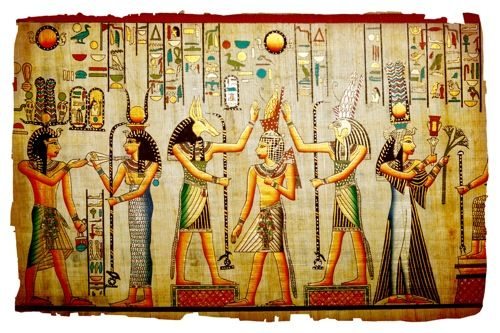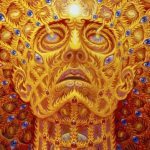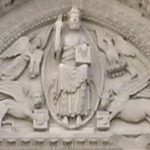Around 20 to 30,000 years ago, the Very Smart Monkey, Homo Sapiens Sapiens, became the dominant species. Genetically, this is modern man. Clean up and educate the average Cro-Magnon, put him in a suit, and he could get a job on Wall Street or Madison Avenue. Archeologists and anthropologists would have us believe that it took the better part of those 20,000 or so years for this Very Smart Monkey to invent sophisticated cultures. The evidence, on a global scale, points to at least one previous planet wide civilization of a very high level, perhaps even by galactic standards.
About 13,000 years ago, this planet wide culture disappeared in a vast and almost incomprehensible cataclysm. For thousands of years, the surviving Very Smart Monkeys struggled simply to exist. Culture fell to a level even lower than the original Smart Monkeys had possessed. It was very dark period.
Fortunately, there were places on the planet where a measure of galactic culture survived more or less intact. The Nile River Valley, which now emptied into the new Mediterranean Sea instead of the Indian Ocean, was one of the most fortunate. The ancient Egyptian historical records tell us that first Hru the Younger, son or reincarnation of Osiris, acted as ruler, then Hru Or, an ancient Light God, and then the Hru Shemsu, or the Followers of Horus, who in turn helped Aha-Hor, unify the country. Somehow, the Egyptians retained their sense of historical identity. Knowledge of this past “other world” connection was never lost. Possibly, the Pyramids of Giza and other monuments remained to remind them of that golden age.
The so-called “Palette of Narmer/Menes,” showing the King unifying the Two Lands and dated to around 3,000 BC, clearly depicts a pyramid in a sacred enclosure on the Lower Egypt side. This first King of the Ist Dynasty’s Horus or royal name, Aha-Hor, means “living breath of Hru,” or more simply, “Essence of Horus.” We can never be sure of Aha-Hor’s motives in unifying the Nile Valley — he may simply have been an opportunistic strong-man — but we can speculate on the importance this Essence of Horus placed on the continuity with the long past golden age. Not only is the pyramid enclosure on his commemorative palette, but on a clear day the Giza plateau, and its structures, would have been plainly visible from the walls of his new city, Memphis. Whether or not he knew he was reviving a fragment of an ancient culture, he was right on time.
The Mayan astronomers of Central America, cultural descendants of the original South American civilization, noted that around 3100 BC, an evolutionary shift occurred. They thought of it as the origin point for a 5200 year cycle of sentient evolution, one that culminates in 2012 AD. Curiously enough, within 400 years, one baktun to the Mayans, eight great cultures had sprung up around the planet. Egypt was one of the stars of this original cultural explosion, as were the cultures in the valleys of Mesopotamia and the Indus River. Other origin cultures, such as the North American Serpent Mound or Adena people or the Mekong Delta culture, played out their evolution in isolation and eventually faded away. Others developed descendent civilizations, as happened in China along the Yellow River and to the Chavan South American culture. The Harappan culture along the Indus River was conquered by nomadic barbarians, as were Mesopotamia and the Northwestern Atlantic coastal megalithic cultures. Only Egypt survived, more or less intact, for over three thousand years.
Egypt then, and to an extent Mesopotamia, (as Z. Sitchin has shown in his 12th Planet series of books) offers us evidence of our non-local origins. Standing as the connective thread between the destroyed high civilization in the past and the new evolutionary cycle, ancient Egypt preserved the basic components of galactic resonance within its mysteries.
However, a counter-force, a type of anti-evolutionary isolationist and materialist undercurrent, existed from the very beginning of Egyptian civilization. Its adherents rallied around the god form of Sutehk, or Set. In the IInd Dynasty, they even became Kings in his name, as the preceding Kings had ruled in the name of Horus. These political maneuvers mirror the deeper conflict between Horus and Set that Egyptian tradition held as the cause of the great cataclysm that destroyed the previous global civilization. In the long history of Egyptian civilization, whenever the political balance shifts in favor of Set, decline sets in. We see this first during the IInd Dynasty. Writing, architecture and art in general declined sharply under the Set Kings, while the restoration of the Horus Kings of the IIIrd Dynasty led to the brilliance of the Old Kingdom, culturally the high point of Egyptian civilization.
During the IIIrd and IVth Dynasties, a city on the eastern rim of the Delta, On or the “City of the Sun,” which the Greeks translated as Heliopolis, achieved an amazing level of spiritual and political influence. This preeminence seems to have been attained with the aid of a group of sages known as the “Assembly of the Shining Beings.” These shining beings, the henmemet in Egyptian, were said to live solely on light that furnished all their needs. They introduced the idea of the solar god, Ra, who sails through the heavens in the boat of a million years. This concept soon incorporated the major shamanic current, the mysteries of Osiris, and, by the Vth Dynasty, replaced Horus as the divine antecedent of the King.
This represented more than a shift in political power. The Ra Cult of Heliopolis supported the older Horus Cult of Edfu, but Ra became the source of divine power and inspiration, in a sense the tutelary deity for the function of Kingship itself. It held this role, with ups and downs and a few judicious mergers, throughout the rest of Egyptian history. Even when combined with the hidden god, Amon of Thebes, or distilled into the Atonist heresy, the Heliopolitan Cult of Ra survived. Christian tradition tells us that the Holy Family, fleeing Herod’s Massacre of the Innocents, hid from Roman patrols in the orchards of Heliopolis. In 640 AD, when the Arabs rode into Egypt on their way to conquer the Byzantine fortress of Babylon, they camped in those same orchards. Heliopolis, where the last remnants of the Priesthood of Ra continued their spiritual activities, fell the next day, ending three thousand years of religious continuity.
Under the guidance of the Sages, the henmemet, Egyptian culture blossomed. We need only look at the art of writing hieroglyphs to see a clear example of the clarification and expansion the Ra Cult brought to Egyptian civilization. The Egyptian language in its hieroglyphic form appeared just before the unification of the Two Lands. The early inscriptions are crude and ill-made, but the language they use is complex and completely formed. There are no developmental stages in hieroglyphic Egyptian. Inscriptions from the IIIrd and IVth Dynasties show no development just a progression, an expansion that includes archaic terms and foreign cultural perspectives within a clearly defined pre-existing language. During the Vth Dynasty, the hieroglyphic form reached its ultimate expression. The Vth Dynasty hieroglyphic inscriptions, such as those in Unas’s pyramid tomb, display an incredible level of artistic mastery as well as creating a symbol/language form that is almost unique on the planet. Only the Classical Maya used anything similar.
Viewed from a distance of almost five thousand years, these facts suggest that the Egyptians learned their unifying language from an incomplete or archaic source. Then, just as they mastered it, they came in contact with the same language, but in a much more advanced form.
The VIth dynasty ended with the long and feeble reign of Pepi II, and the decline of Heliopolitan influence. Egypt fell into a two hundred year period of anarchy. The local gods and goddesses developed followings in this period, giving Egyptian religion forever after the air of a carnival side show on the astral. Worship of Set re-appeared, but was not able to gain any political power. A revival of the Horus faction of Upper Egypt supplied the momentum for a reunification by Mentuhotep II, founder of the XIth Dynasty and The Middle Kingdom.
This 350 year long period can be considered a tribute to the power and cohesiveness of Old Kingdom traditions. Egyptian civilization revived by returning to the ancient canon of life and art. Tombs and pyramids were built, the capital was re-located to Thebes, for the first time, and even foreign trading excursions were revived. This cultural renaissance strengthened the central authority of the state, and Egypt seemed secure until the tragedy of Queen Nefer-Sobek.
The XIIth Dynasty, and the Middle Kingdom, ended with the death of the Queen and her son. The XIIIth Dynasty declined rapidly under a series of sickly royal cousins and venal regents, until another group of cousins started their own dynasty, the XIVth, in the western desert. Both succumbed quickly to the onslaught of the Set worshipping Hyksos.
These “Princes of Foreign Lands” conquered the Delta and began to extend their power up the Nile. For 150 years these “Princes” ruled all of Egypt except for the Upper Nile. The early XVIIth Dynasty of Thebes tried to co-exist with the invaders, but was finally forced to fight a long and bitter struggle to the death. Kamose, last King of the XVIIth Dynasty, brought the war to the very gates of Avaris. It fell to his son, Amose I, to finish them off and found a new dynasty.
In many ways, the New Kingdom of the early XVIIIth Dynasty was the watershed of Egyptian history. The New Kingdom did not merely copy the past, as the Middle Kingdom had. By destroying the Hyksos, (Amose I, not satisfied with conquering Avaris, followed the retreating Hyksos into Lebanon and destroyed their home base) the Egyptians became the greatest military power in the ancient world. The next two Kings completed the process, creating a vast empire that stretched from the swamps of the Tigris and the Euphrates to the Mountains of Ethiopia.
This is the stage on which Tutmose III and Hatshepsut played out their grand opera tragedy of lust and intrigue. Tutmose III would go on to stabilize the borders of the Empire and begin the building spree that would turn Thebes into simply “The City,” wonder of the ancient world. His son, Amenhotep II, would complete his father’s military triumphs and bring the Empire to its zenith.
And, at this crucial moment in ancient history, the Sages of Heliopolis chose to re-appear.
***
A younger son of Amenhotep II camped near the Sphinx one night after a hard day hunting lions on the Giza plateau. In a dream that night the Sphinx appeared and announced that if the prince would clear the sand from around the Sphinx and restore it to its former glory, the prince would become king. Tutmose IV did eventually become king, and left a memorial stele between the Sphinx’s paws recording his prophetic dream. Giza, of course, was the necropolis of On, and restoring the Sphinx meant restoring the prestige of On, or Heliopolis. This spiritual and political shift would have profound significance.
Tutmose IV solidified Egypt’s imperial position and passed to his son, Amenhotep III, a vast and wealthy empire at peace both internally and externally. Amenhotep III had no need or desire to wage war. He turned his talents toward answering the question of human evolution. His grand monument, Luxor Temple, attempted to unify all of human knowledge in a single structure designed to quickened the growth of human sentience. He also realized that a universal state needs a universal religion to support it.
From one of the titles given to the Heliopolitan sun-god, Ra-Harakte or Ra of The Two Horizons, Amenhotep extracted the concept of the Aton, or the power of the sun’s disk. This Aton worship, in Amenhotep III’s vision, would unify all other beliefs into one framework. Not a monotheism, but a unified multi-theism where all the gods and goddesses are but extensions of the one visible source of light, heat, energy and information — the sun’s disk. In this view, the sun then becomes very similar to the light on which the henmemet lived.
From his mummy, Amenhotep III seems to have been a normal Egyptian of his age. Given to his pleasures perhaps, but certainly normal. His son, Amenhotep IV, is a different story. The images we have of Amenhotep IV, or Ahknaton as he is more commonly known, suggest that some type of abnormality had occurred. That it was genetic seems clear. His children appeared to have suffered from the same abnormality. Perhaps the old king’s experiments in evolution had been at least partially successful.
Ahknaton represents an attempt at conscious evolution, one that was unfortunately unviable in the long run. An isolated childhood, the pressures of running the state, the mental disturbances brought on the genetic abnormality itself all contributed in driving Ahknaton into madness. The empire dissolved while Ahknaton conducted elaborate open air rituals to deepen his identification with the sun. In the ruin of his kingdom, after his death, the death of his son and his half-brother, there was no one left to pick up the pieces but a politician and a general.
Ay, an elderly statesman left over from Amenhotep III, tried to hold things together for a few years after the death of Tutanhkamon, but with Ay’s death the general Horemheb became king. Horemheb was not related to the now non-existent royal family in any way. As his death approached, he groomed the prince of a powerful Set worshipping Delta family for the role of founder of the XIXth Dynasty.
Rameses I ruled for a short time and his son Seti I completed the re-conquest of the empire. His son, Rameses II, became the Great Pharaoh, rebuilt the country and carved his name in any blank spot he could find. He ruled for 66 years and when he died Egypt looked mighty, but was actually far gone with decay. Two elderly sons succeeded him, fighting off invasions and accomplishing little else. The New Kingdom, like the Middle Kingdom, ended in a tangle of intrigue and treachery involving a Queen.
The XXth Dynasty started with another Set worshipping adventurer, Setnakht, whose son became the last great king of Imperial Egypt, Rameses III. After 31 years of rule, and a grisly death by black magic and treachery, he was succeeded by a dismal collection of failures all of whom had Rameses in their name.
The Empire fell apart, and Egypt was conquered by the Libyans, the Nubians, the Persians, the Greeks and the Romans. The ascension of the Set worshippers to the kingship was the death knell of Egyptian civilization, although it took a thousand years to die.
The long history of ancient Egypt provides us with some very important pieces of evidence. At the beginning of Egyptian civilization, we catch a glimpse of both the high culture of the distant past and what can only be called a contemporary non-earthly culture of great sophistication. This non-earthly culture, in its local form as the Ra Cult, guided ancient Egypt for two thousand years. Twice, it used a form of direct political and religious intervention to re-orient the culture. In both instances, it neither failed completely nor quite succeeded.
Keep in mind that the Ra Cult itself rode out all the different political and religious upheavals and survived for 700 years after Egypt itself became the property of a foreign power. The wave of Islam swept away all the old forms, pagan and Christian, only to find them re-appearing within the body of the faithful as the many different varieties of Sufi sects. Information of this magnitude will find a way to survive, no matter what form it must take.
In Egypt, we can see the effect of direct contact with that non-earthly higher culture. The secrets however did not become common knowledge; they were hoarded and used as tokens in games of political intrigue. In this we can also see the work of the anti-evolutionary Killer Monkey counter-force among the Set worshippers.
There isn’t space in a work of this type to follow the global pattern of intervention. Egypt will have to stand as our best and clearest example. Given that, let us think for a moment like a member of that non-earthly culture. If the mission is to aid the sentient evolution of this domesticated primate species, then the secret must be simple enough to be understood by any being following the directions. Sort of like the universal picture language found on the emergency instruction cards that international airlines use.
In the first intervention, the IVth and Vth Dynasties, the nature of hieroglyphic writing solidified into a subtle and sophisticated magickal language. The glyphs in Unas’ pyramid tomb were meant to be read by the dead man, pronounced and visualized to create a laser-like coherence of consciousness that led to eternal life. From this, we can begin to extrapolate the nature of the secret; the answer to the question of how can we align with the evolutionary mechanism?
Our use of language and our ability to visualize complex forms, such as glyphs or letters, our ability to relate sound and symbol, allows our thoughts to achieve a coherence, a gravity, that is attainable in no other way. Sentience, on a galactic scale, may be measured in just this fashion.
Other than Egypt and the other origin cultures, can we find more direct evidence linking language, symbol coherence and consciousness expansion with non-earthly, non-local intelligences? Can we find a documented case of contact between these non-local intelligences and an individual or group that involved language and symbol use as a main component of the contact?
The answer is yes, and it happened to the leading scientist of the 16th century, Dr. John Dee, Queen Elizabeth’s court astrologer.
More Articles from Sangraal.com:
Submit your review | |








